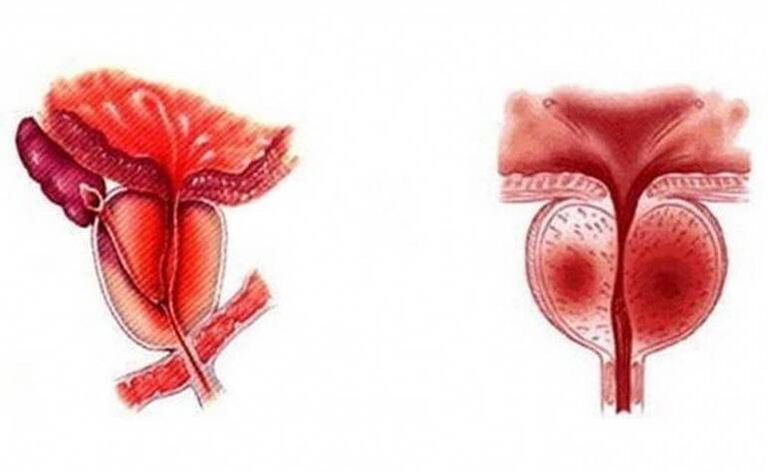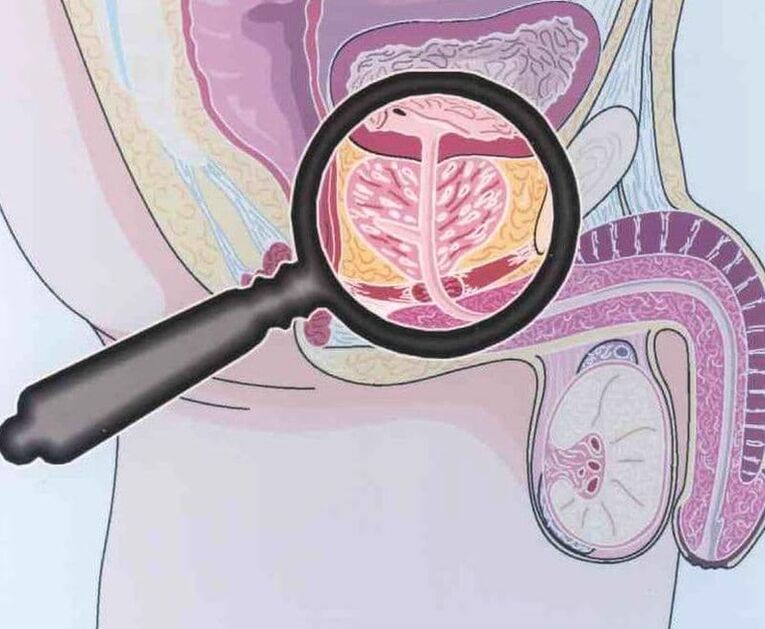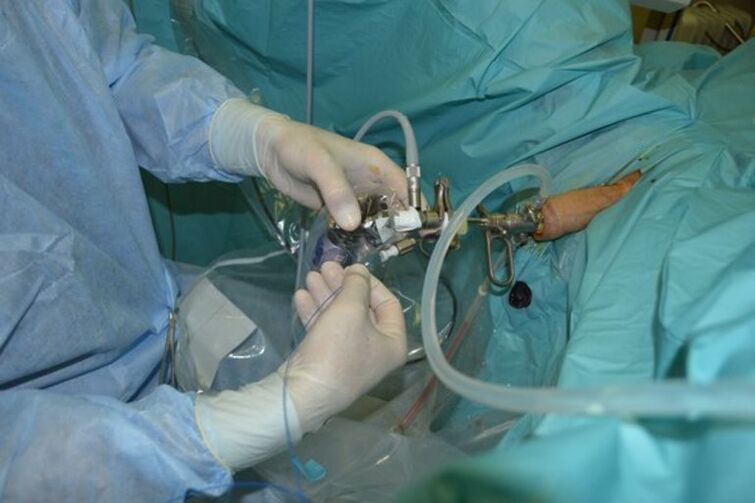Middle-aged and elderly men often suffer from diseases of the genitourinary system related to the prostate gland. This organ is prone to inflammatory processes that cause severe discomfort. The most common pathology is chronic prostatitis. It is difficult to treat and is accompanied by serious clinical manifestations.

Cause of illness
According to statistics, about 30% of men of reproductive age suffer from one form or another of prostatitis. In nearly 70% of cases, the disease has no symptoms, posing a danger to health.There are many reasons for the development of pathology:

- Ignoring the symptoms of the acute form of the disease often leads to its transition to the chronic phase with periodic relapses.
- Frequent hypothermia and catarrhal pathologies often cause gland inflammation.
- A sedentary lifestyle causes stagnation of blood in the pelvis and leads to an interrupted blood supply to the prostate. If men's occupational activities are associated with frequent sitting, the risk of prostatitis increases many times.
- Choose tight underwear that contract the genitals.
- Bad habits (alcohol abuse, smoking) often provoke the development of pathologies, since they contribute to the disruption of all important processes in the body.
- Chronic infectious diseases of the urinary system can also cause pyelonephritis.
- Venereal pathology of acute and chronic forms. If the specialist's recommendations are violated or the symptoms of the disease are ignored, the infection can spread to the gland.
- Constant stress and nervous exhaustion. Such factors can cause pathology, in particular, a simultaneous decrease in immunity.
- Lack of minerals and vitamins in the daily diet can be a predisposing factor. If the deficiency persists permanently, other diseases will join chronic prostatitis.
Having rare sex and not having a regular partner increases the risk of developing chronic prostatitis. Treatment in this case is also delayed, as the patient feels not only physical but also emotional discomfort.
Classification of diseases

Depending on the cause of the onset and course of the pathological process, there are two types of diseases: bacterial and non-bacterial. Separately, experts distinguish asymptomatic or asymptomatic prostatitis. Each species has its own characteristics.
Bacterial prostatitis is easy to detect during diagnostic examination. Tests often reveal the source of the inflammation. In particular, there are many pathogens in the bile secreted during gland massage. In the blood, the level of white blood cells is almost always elevated, because the body produces them in large quantities to fight off pathogens.
The nonbacterial form is characterized by a milder course, but almost always the patient has severe pain in the small pelvis. It is pelvic pain syndrome that is considered the main criterion for diagnosis.
It is difficult to determine the type of disease without symptoms, because there are no obvious signs of inflammation. Pathological changes in the prostate occur, but the man does not feel it. The specialist makes the diagnosis incidentally or while examining other conditions.
Clinical picture
In the acute form of the pathology, a man immediately feels his condition worsen, but in the case of chronic prostatitis there may not be any symptoms, which complicateslots of diagnostic work.With prolonged progression of the disease, the following symptoms will appear:

- discomfort when urinating, extending to the projection area of the bladder;
- often want to empty while reducing the amount of urine excreted;
- discomfort during sex, problems with erection and ejaculation;
- feeling of incomplete bladder emptying related to narrowing of the vas deferens, causing prolonged but ineffective urination;
- the development of cystitis, pyelonephritis associated with the multiplication of bacteria in the bladder and the spread of infection to the kidneys;
- change in color of urine, appearance of impurities of blood or pus;
- decreased sex drive;
- general weakness, fatigue, decreased performance;
- irritability and psycho-emotional stress;
- slight increase in body temperature;
- pain in the pelvis and scrotum, spreading to the sacrum or rectum.
The severity of symptoms depends on the extent of damage to the tissues of the prostate gland. Sometimes the patient only has pain, other than that there are no other symptoms.
If the patient does not go to the doctor for a long time, complications may arise. The most common of which is seminal vesitis, also known as seminal vesicles. Usually, when the symptoms of chronic prostatitis appear at a young age, the patient is diagnosed with infertility, which is difficult to treat.
The most dangerous consequence of untreated or ignored prostatitis is prostate cancer. Often a benign pathology of the organ develops - an adenoma, which can also develop into a malignant tumor.
Diagnostic method
Before treating chronic prostatitis, it is necessary to undergo a comprehensive diagnostic examination. During initial treatment, the therapist interviews the patient, learning about habits, lifestyle, frequency of sex, and occupational activities. The information helps to determine the suspected cause of the disease. The doctor will then listen to the patient's complaints and determine the extent of the gland's damage.

The next step in diagnosis is clinical blood and urine testing. They usually show an increase in white blood cell count and increased erythrocyte sedimentation rate. This indicates the presence of an inflammatory process in men.
The patient must have an x-ray to checkprostate and ultrasound. Thanks to these methods, you can see changes in the structure of the body, deviations in one direction or another. In addition, computed tomography can be performed to identify concomitant pathologies of the genitourinary system.
If a tumor is suspected, a biopsy specimen should be obtained. In the laboratory, experts study the structure of the cell and make a final diagnosis. If the tumor is benign, doctors also determine the possibility of its malignant complication turning into malignancy. After receiving the results of the diagnostic examination, the specialist doctor determines the treatment direction.
Medical therapy
Drug treatment of chronic prostatitis is considered the most common way. Doctors always choose conservative methods if there is a possibility of cure.The commonly used drugs are:
- Antibacterial agents can relieve inflammation in the short term and prevent its spread to nearby organs. Usually, tablet forms of penicillin and fluoroquinolone are used. When the form is running, a powder is prescribed to prepare the solution. The drug is given intravenously or intramuscularly in a hospital setting. With the ineffectiveness of these drugs, macrolides are used, which have a stronger effect. Common drugs in this group are available in tablet and lyophilized form to make a solution for injection. Treatment lasts from 10 to 20 days, depending on the severity of the condition.
- Non-steroidal anti-inflammatory drugs are prescribed to relieve pain and prevent further development of the pathological process. The course is usually no more than 7 days. Patients with digestive problems should not take these medications without first consulting their doctor.
- Muscle relaxants help relax smooth muscles and make urination easier. The duration of treatment and dosage is determined by the doctor.
- Rectal suppositories reduce swelling, pain and inflammation, improving the patient's general condition. The duration of the therapeutic effect is 10-14 days.
In addition, the treatment regimen includes a vitamin complex to strengthen the immune system and quickly restore the body after treatment. Among such funds, there is a complex designed specifically for men. The minimum duration of the reception process is 30 days.
Surgical intervention

If the disease cannot be cured conservatively, the doctor decides to perform surgery to remove all or part of the organ. The absolute indication for surgical intervention is prostate cancer.
Transurethral resection involves dissection of the urethra and removal of part of the gland to alleviate the condition. If excision is not necessary, a simple dissection of the organ is performed to normalize urination.
The surgical method of removing the gland is applied with significant gland growth and accompanying other pathologies. The operation is performed under general anesthesia. This technique is often used to treat elderly patients, when other means and interventions have not been effective.
Using physical therapy

Along with drug treatment, physical therapy is often applied to speed up recovery and prevent complications.The most popular and effective method is massage.prostate gland through the rectum. The technique improves the organ's blood and nutrient supply, preventing the spread of infection to nearby organs.
To achieve a therapeutic effect, it is necessary to conduct at least 10 sessions. The procedure is performed by a specialist in a hospital or clinic.
Electrophoresis on the area of the prostate gland allows you to normalize the blood flow to it. The essence of this technique is to use low-frequency current, which has a positive effect on the state of the genitourinary system, stimulates tissue regeneration, reduces inflammation. The course is at least 10 sessions, sometimes more procedures are needed to get lasting results.
Ultrasound and laser therapy, paraffin therapy, and other methods are commonly prescribed. The choice of treatment method depends on the individual characteristics of the patient's body.
Preventive measures
Compliance with simple rules will help avoid the development of chronic prostatitis. Recommended to avoid hypothermia, lead an active lifestyle. You shouldn't torture your body with intense exercise, but moderate and regular exercise will help prevent blood from pooling in the pelvis and developing prostatitis.
Experts recommend including pumpkin seeds, fresh vegetables, fruits and herbs in your diet. Do not abuse alcoholic beverages. Stopping smoking will reduce the risk of developing an inflammatory process. A balanced diet will help maintain the immune system and prevent colds and other viral illnesses.
To prevent prostatitis, it is necessary to visit a urologist every 6 months. This will detect the pathology at an early stage and prevent its conversion to a neglected form. When the first signs of the disease appear, you should contact a medical facility for timely treatment to avoid complications.































